Termite Mounds on the Bungle Bungle Range in Western Australia
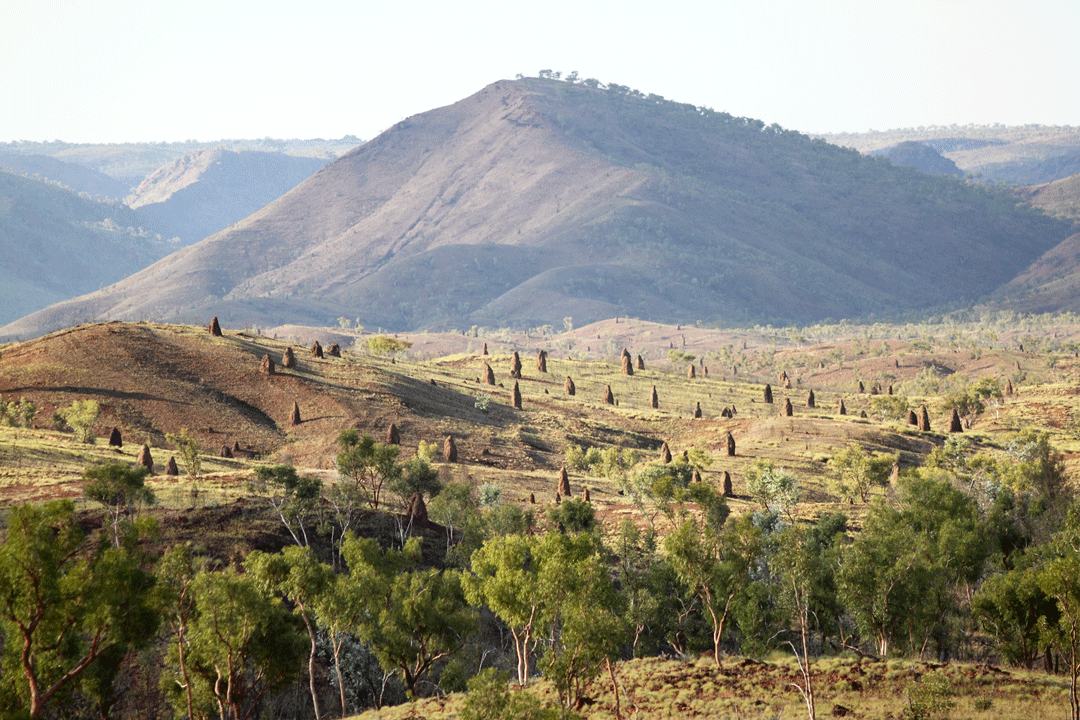
Image credit: Ouderkraal. CC 3.0
In the picture above there appears to be a sparse forest of brown, conical trees. Closer observation reveals, however, that these are not trees at all, but mounds of dirt. These mounds were formed not by erosion, or wind. They were formed by insects, insects that, as a group display a remarkable collective intelligence. These insects, mound-building termites, have created structures from which human engineers and architects are learning lessons. Rather than being pests to be eliminated, these insect builders are an asset to their environment.
Termite Mound in Niger
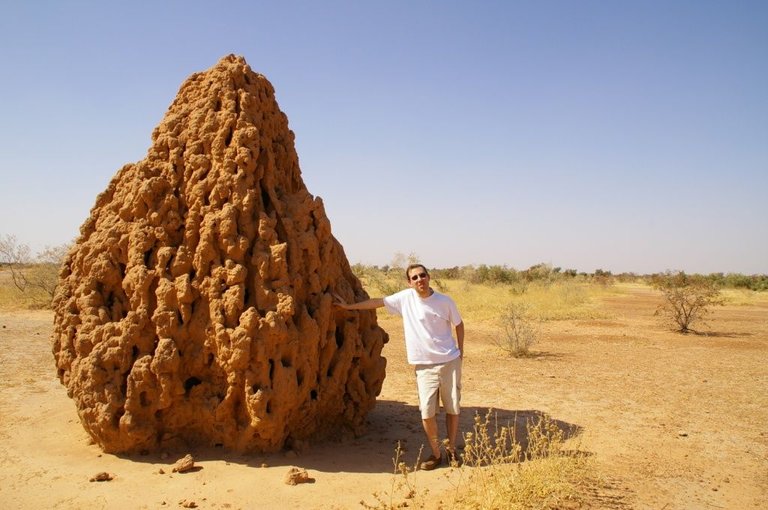
Credit: Mathieu Dessus. Used under CC 2.0 license
A near cousin to the mound-building termite is the subterranean termite. Instead of building mounds above ground, these termite construct large underground colonies. They tunnel from these colonies to wood, wherever they find it. In my community, subterranean termites are significant pests. It's hard to find a home here where termite proofing does not exist. If the insects are undetected they can undermine the structural integrity of a home.
In the picture below are visible hundreds of dead Formosa termites. This is a common invasive species in the U.S. The termites in the picture were swarmers, reproductive termites. They take flight during mating season and try to find a mate. If male and female meet successfully, they will form a nest and start a new colony. The home featured here apparently has a serious termite problem.
Home in Florida, USA, With Dead Termites
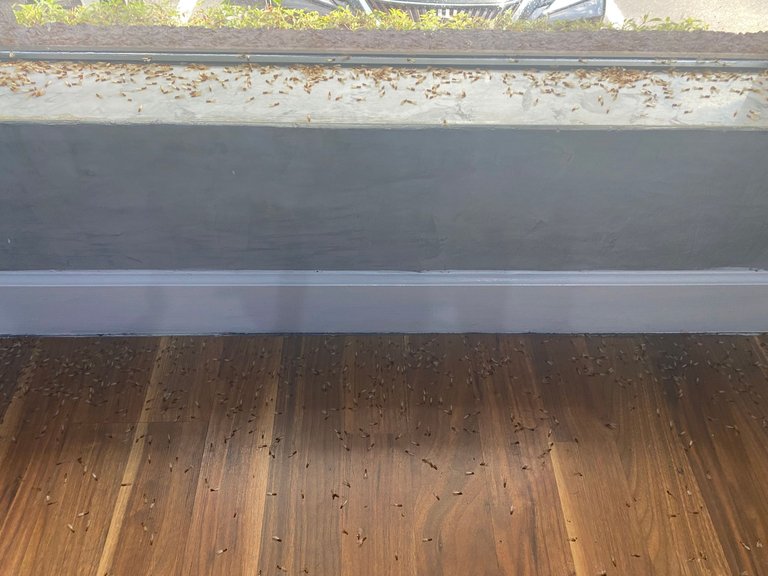
Teechippy. Used under CC Attribution, share-alike license.
The mound-building termite and its subterranean cousin have a common origin: the cockroach. Some 170 million years ago these cousin termites evolved along parallel, but separate paths.
The distinct living styles of subterranean and mound-building termites evolved, scientists believe, in response to biotic (living) and abiotic (non-living) influences.
Mound-Building Termite Soldier
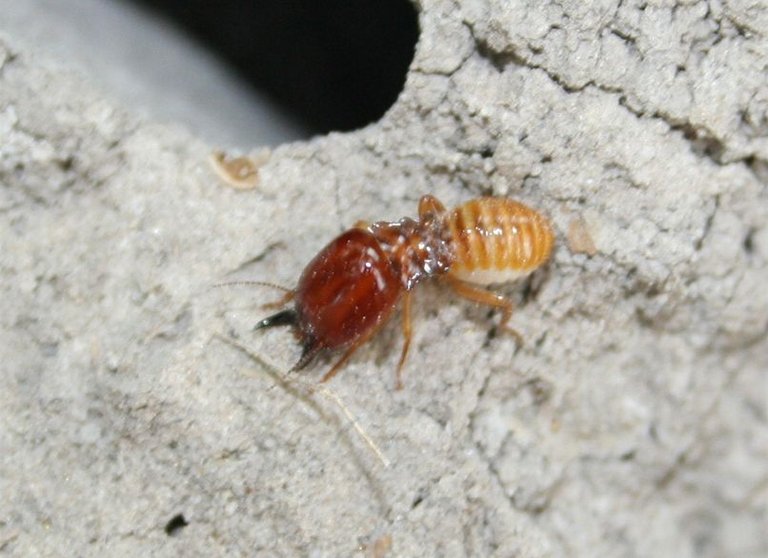
Attribution: Discott. Used under CC 3.0 share-alike license
Termites are eusocial--like bees and ants, but they are not closely related to these insects. They are classified in a different order. Bees and ants are in the Order Heminoptera. Termites are in the Order Isoptera. However, the unschooled eye (mine, for example) might mistake a termite for an ant. Termites are actually sometimes called white ants because of this misidentification. It's especially hard to tell them apart when they are in the winged (reproductive) stage.
Here is a brief YouTube video that shows the distinction between the two insects:
As the video shows, they have very distinct body types.
Although the termite has traditionally been classified in its own order, Isoptera, recent genetic analysis challenges that classification. It seems the termite did not leave its cockroach ancestry behind. DNA analysis shows such close similarity between the cockroach and the termite, that there has been a movement to include the Order Isoptera in with the Order Blattodea--the cockroach order. Blatodea encompasses over 4000 species of cockroach and 3000 termite species.
Some have described the termite as a social cockroach. Those of us who have battled cockroaches in the past can now better understand the subterranean termite's tenacity when it is attempting to eat the wood in our homes :))
Eusocial
The key to the success of both ant and termite colonies is their social nature. Both are eusocial--they live within highly organized communities where the survival of the group is dependent on each member doing its job cooperatively. Sometimes it is said that humans are eusocial, but 'loosely' eusocial.
In the picture below I believe we can see worker termites. I'm making a guess as to their cast based on other pictures and descriptions I found on the web. The cast is not identified in this picture. The workers are generally pale in color and smaller than soldiers. They are blind. They are the most numerous in a colony and are designed to chew. They digest food and feed others in the colony through trophallaxis.
Worker Termites
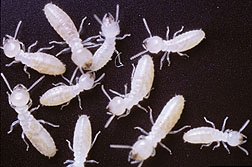
Alfredo Flores, USDA Forest Service. Public
In eusocial species, such as the termite, the members of a community work so closely together that as a whole they create what might be called a 'super organism'. This complex structure, which in mound-building termites is manifested in the mound, is comprised of colony members working in seamless cooperation.
There is a strict cast system and each worker's role is defined for life. The function of the caste members is reflected in their morphology. In the picture of a soldier termite (earlier in this blog), for example, we can see the large head and mandibles, used for defense of the colony.
The largest members of the termite colony are the king and queen.
Termite King and Queen (With Soldier, Perhaps?)

Archiri Bitamsimli. Ghana. Used under CC Attribution share alike license.
Unlike in eusocial bee and ant colonies, the king termite remains by the queen's side as she performs her only task, which is to lay eggs and provide new members of the colony. The king is larger than other termites in the colony, though not as large as the queen. He plays a vital role in the colony. Not only does he daily inseminate the queen, but he also releases vital pheromones.
I found a video that shows the interaction between the royal couple and the rest of the colony.
https://news.cnrs.fr/videos/inside-a-termites-nest
The queen also releases pheromones which it is believed influence the development of eggs. Pheromones are critical to the colony. It is the release of pheromones that determines the cast of each termite as it develops from an egg. Workers and soldiers are created sterile and the social balance of the colony is maintained.
A queen can be huge...up to six inches long. In this Youtube video you get to actually see a queen in action. She is so huge that she is immobile. It has been suggested that the queen does not so much rule the colony as she is ruled by her ovary.
The queen is eventually immobile, and helpless until she dies. Meanwhile she can produce 30,000 eggs a day, for her lifespan of 15 years. It is the job of the workers and soldiers to see that she is fed, tended and protected. When the queen dies, it often signals the death of the colony, although the queen may be replaced in some cases.
The Mound Builders: Macrotermitinae
The essential difference between mound-building termites and subterranean termites is diet. The subterranean termite feeds exclusively on wood, cellulose. That's why this termite presents a danger to wooden structures and even to trees. The subterranean is considered a pest because of its voracious appetite for wood.
However, the mound-building termite has a more varied diet. The secret to being able to consume this diet is in its gut. While the subterranean termite has enzymes in its gut that break down cellulose, the mound builders do not. They have an almost complete complement of enzymes but are lacking one for cellulose digestion. So, over time they evolved a way to obtain this enzyme. They became farmers.
Many mound-building termites grow a fungus, Termitomyces, that produces the enzyme they need. This fungus becomes part of their diet and therefore offers the one necessary enzyme for digesting cellulose.
I found a diagram of a typical mound-building termite farm, with fungus, termites, queen and eggs indicated. My thanks to Professor Meike Piepenbring from Goethe University in Frankfurt, Germany for this quite informative diagram.
Diagram of Termite Farm in a Mound-Building Termite Colony
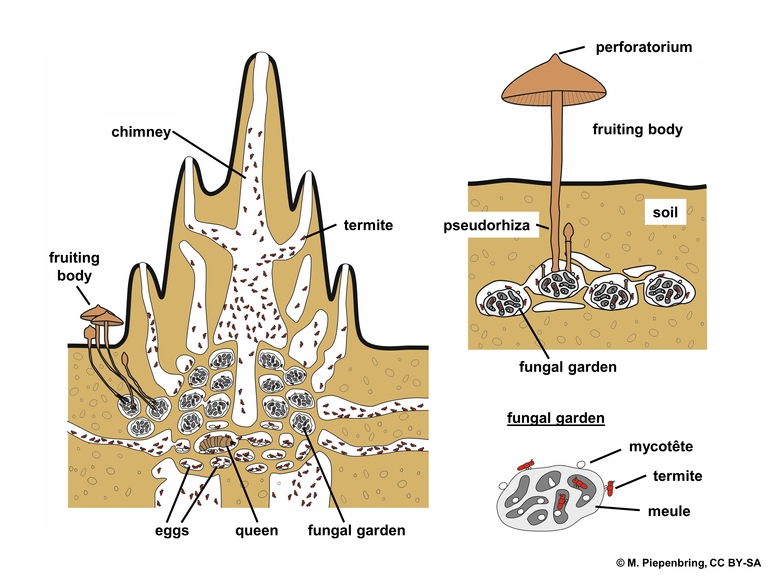
Prof. Meike Piepenbring. Used under CC 3.0 share alike license.
The fungus is referred to as an 'obligatory fungal symbiont', because the fungus and the termite have a symbiotic relationship that is essential to the survival of both.
Termites collect debris from the surrounding area, provide nutrition for the fungus, and then nurture the fungus with the nutrients. In order to perform this nurturing task, the termites have developed two worker casts of workers. There are the foragers, called major workers. These go out into the environment and collect the debris, dung, whatever nutritional elements go into the fungus diet. The second cast of workers, minor workers, do the actual farming. Their farming process is quite complex and is described briefly in a passage from the journal Microbiology Reviews.
(The minor workers) construct complex combs from their faeces within chambers either within or adjacent to the hive. In addition to providing a physical structure, termite faeces also contain a mixture of fungal asexual spores that inoculate the combs and partially digested plant materials that promote Termitomyces growth.
Diversity Among Mound-building Termites
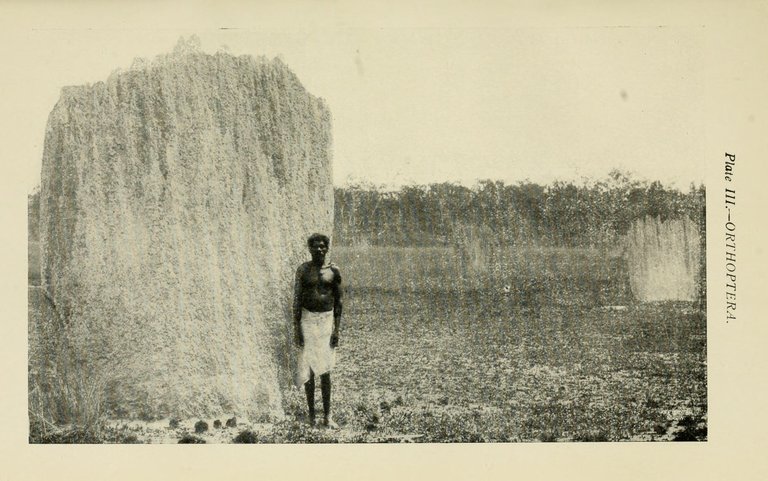
Mound of Ameritermes meridionalis Credit: W.W. Frogatt. 1907. Public.
In this blog I have been referring to mound-builders as though they are a homogenous group. They are not. There is wide diversity among the mound-builders. It seems that not all grow fungus. Amitermes meridionalis, for example (mound pictured above), a species of mound-builder native to the Northern Territory of Australia, eats grass.
Benefit to Environment
Mound-building termites are regarded as a keystone species in many parts of the world. In South America, for example, Cornitermes cumulans is a keystone species in the grasslands of Brazil.
Cornitermes Cumulans Alate
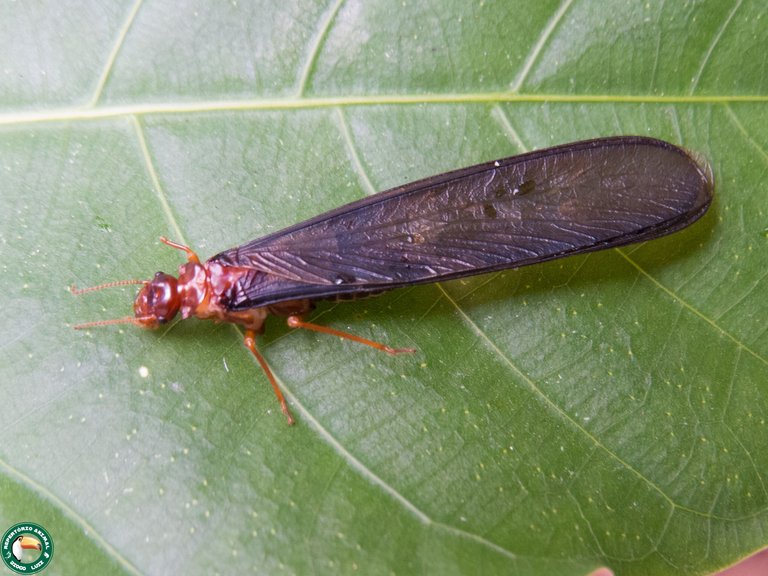
Credit: Diogo Luiz. Used under CC attribution share alike 4.0 license.
Mound-building termites enrich the soil in which they build their mounds. Just to touch on a few of the ways mound-builders are important to an ecosystem:
- They clean debris that would otherwise accumulate in the environment
- They cycle nutrients from this debris and return it to the soil
- They turn the soil
- They are a food source for a wide variety of animals, including humans
- Their abandoned nests provide habitats for other animals
Here is an HHMI Biointeractive video that illustrates how the mound-building termite enriches the ecosystem.
This is what happens in mound-building termite society.
Conclusion
There are so many aspects to the topic of mound-building termites that I have to leave a lot of important material unaddressed. One of the most interesting, and important, aspects of this termite's lifestyle is the engineering that goes into building their mounds. The relevance to human architecture and engineering is significant. We are learning from these insects.
An intriguing aspect of mound-building termite architecture is the ventilation system they design to control temperature and humidity in the inner chamber. They construct chimneys and air vents that turn the mound into a kind of lung that takes in air and expels it. The goal is to keep the temperature and humidity of the inner chamber constant. Not only the royal chamber, where the precious queen resides, but food and other chambers must also be temperature controlled.
Here is a video that offers an explanation for how the mound works. However, there are still mysteries about how the termites manage this amazing architectural feat.
Today's architects and engineers are learning about smart design from the mound-building termite. Here is another video that explains how one building (there are others) in Zimbabwe was built with the termite ventilation system in mind.
Thank you for reading my blog. I found this subject irresistible. The more I wrote, the more I discovered. It is a subject that will certainly be revisited.
Peace and health to all.
Some resources used in writing this blog
https://www.cbc.ca/radio/thecurrent/the-current-for-november-23-2018-1.4917641/just-unbelievable-termite-mound-network-the-size-of-great-britain-discovered-in-brazil-1.4917643
https://esajournals.onlinelibrary.wiley.com/doi/full/10.1002/ecs2.2148
https://www.asme.org/topics-resources/content/what-termites-can-teach-engineers
https://media.hhmi.org/biointeractive/click/keystone/termite.html
https://asknature.org/innovation/passively-cooled-building-inspired-by-termite-mounds/
https://www.newcivilengineer.com/latest/termites-crowned-top-engineers-of-natural-world-01-04-2016/
https://phys.org/news/2024-02-cathedral-termite-mounds-lunar.html
https://www.imeche.org/news/news-article/feature-nature%27s-engineers-inspire-sustainable-building-designs
https://www.researchgate.net/publication/201996995_The_mound-building_termite_Macrotermes_michaelseni_as_an_ecosystem_engineer
https://www.princeton.edu/news/2015/02/05/tiny-termites-can-hold-back-deserts-creating-oases-plant-life
https://news.miami.edu/stories/2022/09/termites-may-have-a-larger-role-in-future-ecosystems.html
https://www.biointeractive.org/sites/default/files/termites-2015-poster.pdf
https://www.jjext.com/12649-2
https://www.nsf.gov/news/news_summ.jsp?cntn_id=134006&org=NSF
https://science.thewire.in/environment/why-termite-mounds-are-wonders-of-architecture-and-natural-engineering/
https://www.lviassociates.com/blog/2023/09/architects-look-to-termite-mounds-to-improve-building-ventilation
https://www.bbcearth.com/news/what-termites-can-teach-architects&ocid=twert
https://india.mongabay.com/2020/10/architectural-secrets-of-termite-mounds/
https://academic.oup.com/biolinnean/article/126/2/304/5251914
https://www.canr.msu.edu/resources/biotic-abiotic#:~:text=Description,is%20critical%20in%20an%20ecosystem
https://australian.museum/learn/animals/insects/what-are-the-differences-between-ants-and-termites/)
https://www.nwf.org/Educational-Resources/Wildlife-Guide/Invertebrates/Termites
https://entomology.k-state.edu/outreach-and-services/diagnostician/lab-news/winged-ants-vs-termites.html
https://arthropod-systematics.arphahub.com/article/75819/
https://en.wikipedia.org/wiki/Blattodea
https://www.ncbi.nlm.nih.gov/pmc/articles/PMC3279739/
https://encyclopediaofarkansas.net/entries/termites-14997
https://www.sciencedirect.com/topics/agricultural-and-biological-sciences/trophallaxis
https://www.ncbi.nlm.nih.gov/pmc/articles/PMC3279739/
https://www.britannica.com/animal/termite/Nests
https://www.lsuagcenter.com/profiles/lbenedict/articles/page1558637166771
https://pestaid.com.au/things-to-know-about-the-king-termite/
https://www.ncbi.nlm.nih.gov/pmc/articles/PMC3169079/
https://www.q-files.com/life/insects/termites
https://www.npr.org/2011/05/06/136028437/a-termite-queen-and-her-ultimate-sacrifice
https://www.realclearscience.com/blog/2021/10/30/six_ridiculous_facts_about_termite_queens_800088.html
https://royalsocietypublishing.org/doi/10.1098/rsos.230126
https://www.ncbi.nlm.nih.gov/pmc/articles/PMC9779920/
https://en.wikipedia.org/wiki/Amitermes_meridionalis
https://media.hhmi.org/biointeractive/click/keystone/termite.html
https://www.mightymitetermite.com/blog/do-termites-have-predators/
https://www.harvardmagazine.com/2015/10/harvard-study-finds-that-termite-mound-functions-as-lung-that-sneezes-carbon-dioxide
https://termitemoundthermogation.weebly.com/mound-thermoregulation.html
A very complete publication @agmoore, in this writing you reveal one of the groups of the class of insects that are usually very detested by people because of the great damage they can do in wooden structures, in my country there are no houses of this material, but termites make theirs with chairs, books or tables if appropriate measures are not taken. Excellent that you mention the change of termites from Isoptera (infraorder) to Blattodea (order), becoming part of the taxon that groups the popular cockroaches, to cite examples.
The termites are part of the very striking insects for being eusocial, thus, from being a single organism, when they unite for a cause they become what is usually called "superorganism" because they act disciplined and together, the same thing happens with ants, bees, etc.
The thing about termite mounds in Australia is really amazing, I didn't know that, although in Australia you always see very fascinating things in terms of animals, they have a very striking and unique diversity. I really liked your post, that's why I shared it a few days ago also on my blog. A hug and good weekend @agmoore.
Thank you very much, my friend @abneagro. I have to do a lot of reading in order to right one of these blogs, because I'm learning as I write. Thank you for letting me know I got it right:)
There was so much that surprised me as I researched the blog--especially that termites are now classified with cockroaches. Both insects are detested by many people, and yet both are considered food in some parts of the world!!
I appreciate your kind comment and your reblog. Hope you are having a wonderful weekend.
Your friend,
AG
Oh, dear! I feel so sorry for the immobile, ginormous queen termite and her 30 000 eggs a day. Geez, what a weird life.
Marvellously interesting! I was immersed and read the entirety to mom over dinner, who decided to cry over the fate of the queen termite. She’s a softy!
⭐️⭐️⭐️
I agree with Mom. It's almost inconceivable to us, the destiny of living 15 years, a long lifetime, imprisoned by a tireless ovary. And yet, the queen embraces her fate. Amazing that every insect in the colony has no regard for its individual fate--almost has no concept of its individuality. That sort of collectivism is something to which I think humans cannot relate. Probably explains why termites have been around for 250 million years!!
Thanks very much for reading my long blog, dear @itsostylish, for commenting and for supporting my work here.
Tell Mom I'm sorry she was upset♥️. The price of being royal 🌈
The engineering of the mounds is incredible. I don't think I've ever seen this before.
Our termites are subterranean; we struggle a little every 5 or 6 months to keep them under control in our house, because it's an old house with trees in the back and front yards, and there's also wood in the interior structure of the house. It was a pain in the neck when we moved in and there had been no one to exterminate--or rather control them--for a year. At first, I thought, “these ants have really big heads,” hehe, but then I saw them up close and thought, “these aren't ants, are they?” I didn't know what they were at the time.
We could save a lot of energy and reduce pollution by learning from this kind of ingeneering. Amazing.
Hope you're enjoying your Sunday, dear @agmoore ☕️
Hello my friend @marlyncabrera,
When we bought our house last fall one of the stipulations in the sale was that the previous owners treat the place for termites. These insects are tireless in my area. It is something I know we will have to repeat every year.
They do look like ants, don't they?
😂
I actually saw a video where one of the soldier termites latched onto a woman's finger with its huge mandibles. The termite drew blood!!
Thank you for stopping by and for commenting. I am having a peaceful Sunday. I hope the same is true for you.
😂
Imagine a horror B-movie about a vampire termite 😂
My Sunday is quiet and cool so far. Thank you 💓
They can live up to 50 years... and I'd like to know how
😂
You've just stolen the idea for my next science post :)
I think that fellow is getting ready to eat the thing. I understand termites make a tasty, nutritious meal😮
Wow! An impressive take on termites, very comprehensive and informative. Got curious because our doors, cabinets, bookshelves, and books here in school have been destroyed by these powerful insects.
Thank you! I try to write only about subjects that interest me personally. The problem with that is, I get so interested I can't stop reading and writing :)) This is a fascinating subject and I'm glad it caught your interest.
Good luck with the termites😄
Yeah, that's my impression reading your piece.
!PIZZA
!LOLZ
Excellent post! Congrats!
Thank you very, very much. Your assessment is gratifying. Thanks very much for the support🌺
What a magnificent article on the hidden world of termites. The research is superb. Their caste system is fascinating, and I think that humans also share some of those socio-structural traits, though in a different and more complex manner.
On a trip to Costa Rica I saw this large black pockmarked structure on a tree. The guide told us it was a termite nest, and when he poked it and broke a piece off, the little termites came out. He put his hands on it and the termites crawled all over it but didn't harm him. So at least they're docile if a little icky 😄
Fantastic post, @agmoore!
Thank you my friend, @litguru,
It was relaxing, getting lost in this topic. Whenever stuff started to get to me (at home) I would go back and read about these little critters. Termites aren't really a reassuring topic, but getting lost in the research for me is something like what knitting is for other people. It takes my mind away to a calming place. The result is a very long, comprehensive blog :)))
Thanks for reading the whole thing. Your comment and support are much appreciated.
It was actually entertaining to read the little details, even if they are descendants of cockroaches, they don't incite that yucky feeling in me 😁
Thanks for your contribution to the STEMsocial community. Feel free to join us on discord to get to know the rest of us!
Please consider delegating to the @stemsocial account (85% of the curation rewards are returned).
Thanks for including @stemsocial as a beneficiary, which gives you stronger support.
Thank you very much, @stemsocial. Your support is much appreciated.
Wow, this is fascinating, @agmoore. Those termite mounds are so enormous. I've never seen such a thing. Your research is just incredible. So thorough and insightful!
Thank you @jayna,
I really appreciate that you took the time to read this long post! It was a pleasure to research and write. There is so much information out there, and yet so much to learn about these complex societies.
Thanks very much for the kind words.
Termites are fried and eaten in my country...
That's one thing to be added to your research 😂😂
Actually, I did mention that people eat them :))
While I'm not normally someone overly interested in bugs, your post pulled me in to learn more. Well done!
Thank you! That's quite a compliment :)
At least the mounds are easy to see from far away!
That's true :))
That Cornitermes Cumulans looks like an ant
Never seen it before…
Yes, it does look like an ant! Thank you for commenting.
It's really amazing how compact they make skyscrapers
Thanks for stopping by.
You're welcome 👍😉
$PIZZA slices delivered:
@rzc24-nftbbg(3/5) tipped @agmoore
Congratulations @agmoore! You have completed the following achievement on the Hive blockchain And have been rewarded with New badge(s)
Your next target is to reach 180000 upvotes.
Your next target is to reach 16000 replies.
You can view your badges on your board and compare yourself to others in the Ranking
If you no longer want to receive notifications, reply to this comment with the word
STOPThank you for the notice @hivebuzz :)
That's great @agmoore! We're here to encourage you to achieve your next goals on Hive!
BTW, we noticed we miss your support for our proposal. Mays we ask you to check it out and consider supporting it?
All you need to do is to click on the "support" button on this page: https://peakd.com/proposals/248.
Thank you!